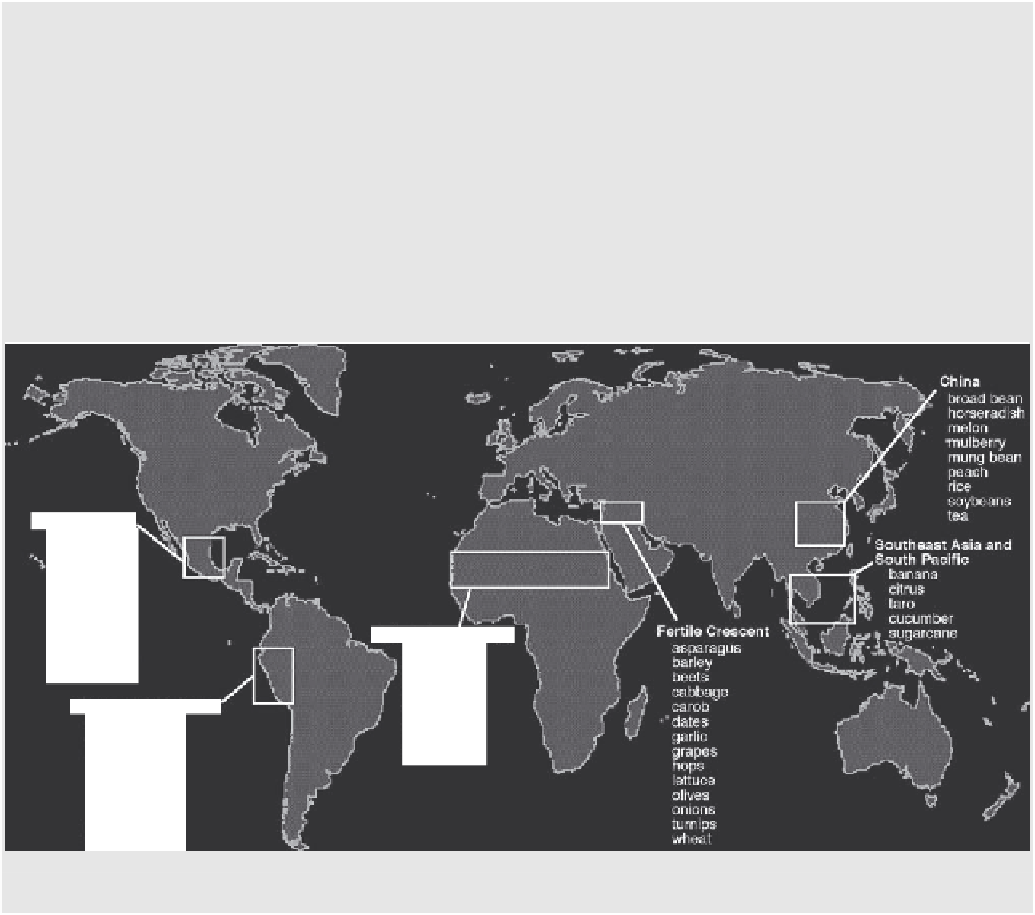Agriculture Reference
In-Depth Information
ORIGINS OF AGRICULTURE
Between 4000 and 10,000 years ago, agriculture arose independently in several different areas of the world, each
with its own geography, climate, and indigenous flora and fauna. Six widely recognized centers of early agricultural
development are shown on the map in Figure 14.3. The center in China is sometimes divided into two subcenters,
the Yangtze River Valley in the south and the Yellow River Valley in the north. The Southeast Asia and South
Pacific “center” is diffuse, spreading over a somewhat larger area than indicated. Some researchers add other centers
to this list: one in the Ohio and Mississippi River valleys of North America, and one on the Indian subcontinent.
What these regions had in common is high natural biological diversity, variable topography, and climate, and
human cultures ready to exploit the potential benefits of more intensive management of edible plant species. Since
the local flora in each center was made up of a distinct assemblage of plant families and genera, the kinds of plants
domesticated in each region varied greatly.
China
broad bean
horseradish
melon
mulberry
mung bean
peach
rice
soybeans
tea
Southeast Asia and
South Pacific
banana
citrus
taro
cucumber
sugarcane
Meso-America
avocado
beans
cacao
chili peppers
corn
pumpkin
squash
tomato
upland cotton
vanilla
Fertile Crescent
asparagus
barley
beets
cabbage
carob
dates
garlic
grapes
hops
lettuce
olives
onions
turnips
wheat
Sub-Saharan Africa
coffee
oil palm
okra
millet
sesame
sorghum
watermelon
yams
South-Central Andes
amaranth
chili pepper
common bean
potatoes
lima bean
manioc
peanut
quinoa
sweet potato
FIGURE 14.3
Centers of early agriculture and plant domestication.
desired parts and products — better wool, larger and more
numerous eggs, more liters of milk, or more muscle tissue.
This selection process has, among other things, greatly
altered the physiologies and morphologies of the domes-
ticated species. In domesticated plants, carbon partitioning
operates very differently than carbon partitioning in wild
species. Crop plants store a much greater proportion of
their biomass in their edible or harvestable parts than do
the natural species from which they were derived. As a
consequence, less energy is partitioned for use in traits or
behaviors that confer
environmental resistance
— the abil-
ity to withstand stresses, threats, or limiting factors in the
environment. In addition, many traits that once conferred
environmental resistance have been lost from the genotype
altogether. An analogous change has occurred in domes-
ticated animal species. Because of these fundamental
changes in the genetic basis of their physiology and mor-
phology, many domesticated species and varieties require
completely artificial and optimum conditions. For plants,
this means ideal soil moisture, nutrient availability, tem-
perature, and sunlight, as well as the absence of pests, in
order to perform well and express the high-yield traits for
which they were selected. For animals, it often means
controlled climatic conditions, antibiotics, and artificial
insemination (the turkey breed that accounts for nearly all
turkey production in the U.S. cannot reproduce without
human assistance because body structure and extra meat
limit animal movement).
Directed selection in agriculture has therefore led us
into a difficult situation. Our major crop varieties require
external inputs of inorganic fertilizers, pesticides, herbi-
cides, and irrigation water to perform as designed, and
many of our domesticated animals require hormones and
antibiotics, highly controlled conditions, and highly pro-
cessed feed. But such external inputs are the major cause
of agriculture's negative effect on the environment and on






Search WWH ::

Custom Search